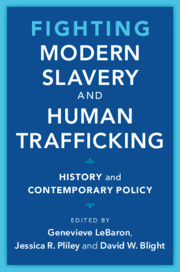Book contents
- Fighting Modern Slavery and Human Trafficking
- Slaveries since Emancipation
- Fighting Modern Slavery and Human Trafficking
- Copyright page
- Contents
- Figures
- Tables
- Contributors
- Preface
- Acknowledgments
- Abbreviations
- 1 Introduction
- 2 Counting Modern Slaves
- 3 Working Analogies
- 4 Free Soil, Free Produce, Free Communities
- 5 Ambivalent Abolitionist Legacies
- 6 Mexico’s New Slavery
- 7 Undermining Labor Power
- 8 A Market in Deception? Ethically Certifying Exploitative Supply Chains
- 9 Preventing Human Trafficking
- 10 Integrated and Indivisible
- Afterword If There Is No Struggle, There Is No Progress
- Index
10 - Integrated and Indivisible
The Sustainable Development Agenda of Modern Slavery Survivor Narratives
Published online by Cambridge University Press: 18 June 2021
- Fighting Modern Slavery and Human Trafficking
- Slaveries since Emancipation
- Fighting Modern Slavery and Human Trafficking
- Copyright page
- Contents
- Figures
- Tables
- Contributors
- Preface
- Acknowledgments
- Abbreviations
- 1 Introduction
- 2 Counting Modern Slaves
- 3 Working Analogies
- 4 Free Soil, Free Produce, Free Communities
- 5 Ambivalent Abolitionist Legacies
- 6 Mexico’s New Slavery
- 7 Undermining Labor Power
- 8 A Market in Deception? Ethically Certifying Exploitative Supply Chains
- 9 Preventing Human Trafficking
- 10 Integrated and Indivisible
- Afterword If There Is No Struggle, There Is No Progress
- Index
Summary
This chapter takes up the challenge to see the United Nations Sustainable Development Goals (SDGs) as integrated and indivisible, and does so through the lens of slavery survivors’ own accounts. It draws from a major new collection of contemporary survivor narratives to answer a key question: which SDG target achievements are more likely to prevent or end enslavement? Focusing on India and on forced marriage as a case study, it looks beyond the SDG targets on forced labor (8.7) and forced marriage (5.3) themselves to identify three main SDG target issues as drivers of enslavement: 1.2 (poverty), 4.5 (gender disparities in education), and 5.1 (discrimination against women). Survivors also highlight the multi-directional relationships between these target issues that led to their exploitation. As an approach, this multi-SDG coding of narratives suggests that survivors’ own voices could be more central to the global antislavery and development agendas. In the detail of individuals’ unique lived experiences, we can identify the interrelated causal factors for vulnerability, and better enable the global antislavery community to tackle the socio-economic, cultural, and political drivers for slavery that are embodied in a range of SDG target combinations.
Keywords
- Type
- Chapter
- Information
- Fighting Modern Slavery and Human TraffickingHistory and Contemporary Policy, pp. 203 - 224Publisher: Cambridge University PressPrint publication year: 2021
- 1
- Cited by

